“Ritual Drum (Dhyangro)” has been added to your cart.
View cart
-
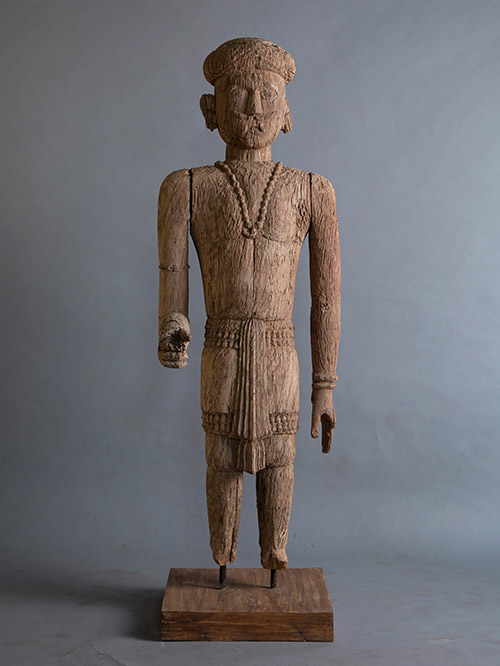

Coastal Karnataka (Bhuta culture)
Wood
A rare figure of a male donor chief. He wears a turban, has a prominent moustache and is decked with typical jewellery including a single strand necklace with a pendant, armlet and earrings. He wears an unstitched garment tied at the waist with pleats at the front, called a mundu.
The bhuta tradition is popular on the Malabar coast. Bounded by the dramatic sweep of the forested ghats to the east and the Arabian sea to the west, and encircled by rivers, the South Kanara district of coastal Karnataka has enjoyed relative geographic isolation until recent years. This has enabled the region to retain specific pre-Hindu belief systems and associated rituals, virtually intact, over several hundred years. These practices have a distinct identity of their own, although they have become linked in a variety of ways with mainstream Hinduism. Though now primarily confined to Coastal Karnataka, Bhuta cults once existed all over India under different names and forms. The factions, which are of considerable antiquity, have much in common with those of the yakshas (mysterious semi-divine beings), for instance.
Size (cms): 147(H) x 44(W) x 54(D)
Size (inches): 58(H) x 17.5(W) x 21.5(D)
-
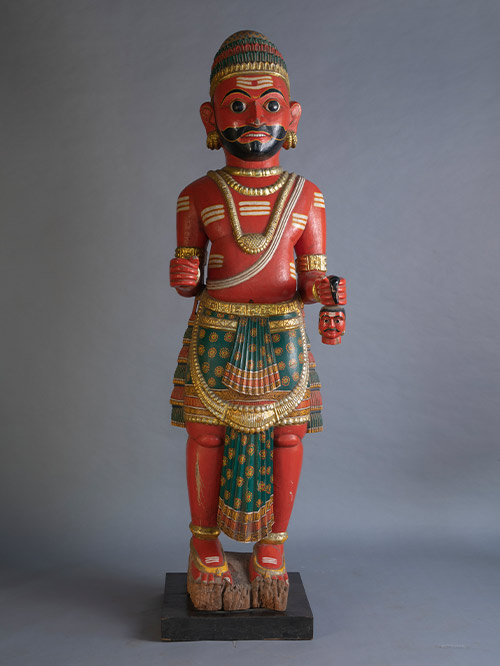
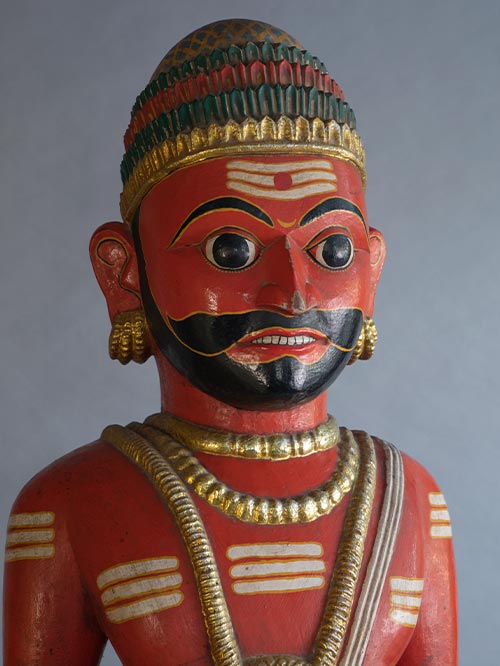
Coastal Karnataka (Bhuta culture)
Wood
A rare figure of a Virabhadra in the form of a Bhuta. He wears a turban, has a prominent moustache and beard and is decked with typical jewellery including a single strand necklace with a pendant, armlet and earrings. He wears an unstitched garment tied at the waist with pleats at the front, called a mundu. He carries in one hand the head of a slain enemy and in the other, he would have held a sword.
The bhuta tradition is popular on the Malabar coast. Bounded by the dramatic sweep of the forested ghats to the east and the Arabian sea to the west, and encircled by rivers, the South Kanara district of coastal Karnataka has enjoyed relative geographic isolation until recent years. This has enabled the region to retain specific pre-Hindu belief systems and associated rituals, virtually intact, over several hundred years. These practices have a distinct identity of their own, although they have become linked in a variety of ways with mainstream Hinduism. Though now primarily confined to Coastal Karnataka, Bhuta cults once existed all over India under different names and forms.
Size (cms): 188(H) x 56(W) x 56(D)
Size (inches): 74(H) x 22(W) x 22(D)
-
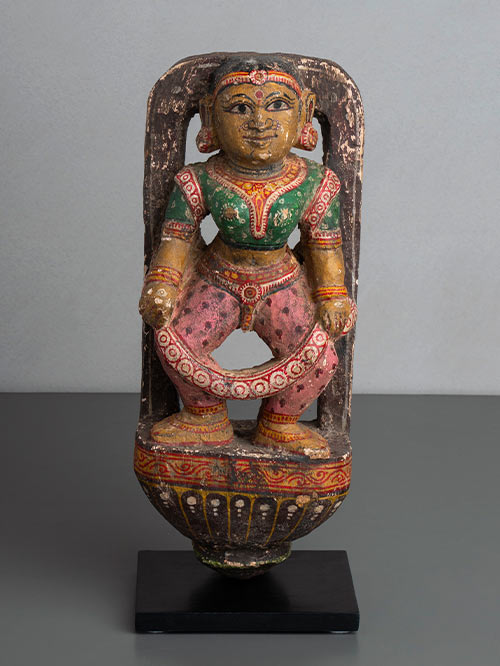
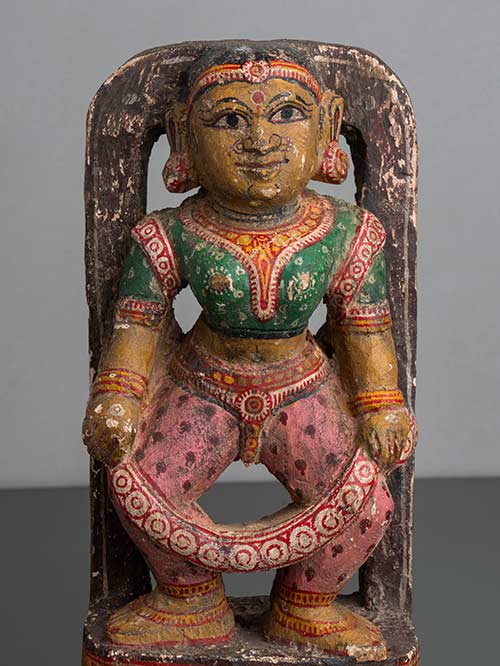
Orissa
Wood, polychromed
An elegant figure of an apsara wearing a patterned blouse. The apsara is adorned with extensive jewelry, including multiple hand and leg ornaments. She has a stylised form with a narrow waist and large breasts, and she holds a floral garland in front of her. Her full face features a pronounced chin, large arched eyebrows over bulbous eyes, and a gentle smile.
Apsaras means ‘essence of the waters’ or ‘moving in or between the waters’. The Apsaras are divine beauties, the dancers of the gods, who dwell in Indra’s paradise, svarga (heaven). Mistresses of the Gandharva’s (semi divine beings) and, occasionally, of men, they can assume any form at will. Generally they are believed to have originated from the churning of the ocean, alone with the wish fulfilling Parijata, their favoured tree. They are often sent by the gods to seduce Rishis (holy men) and ascetics. Heroes who fall in battle are swept away to Svarga by the Apsaras. They are reputed to dwell in trees along with the Gandharvas. The chief of the Apsaras is Urvashi.
Size (cms): 33.5(H) x 13(W) x 10(D)
Size (inches): 13(H) x 5(W) x 4(D)
-

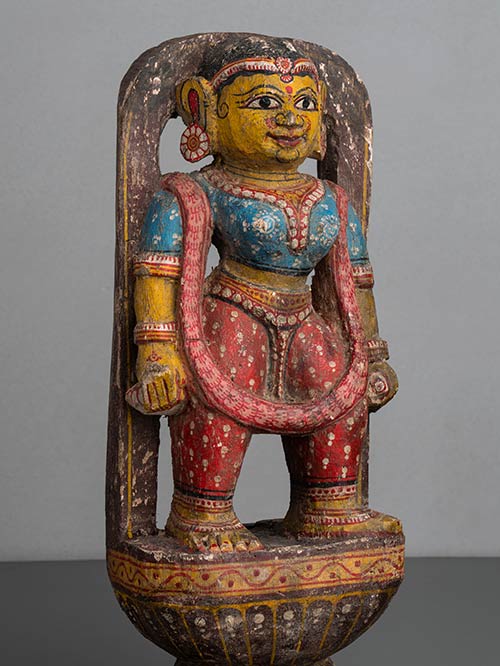
Orissa
Wood, polychromed
An elegant figure of an apsara wearing a patterned blouse. The apsara wears extensive jewellery; including multiple hand and leg ornaments. She has a stylised form with a narrow waist and large breasts and carries a conch in either hand. She has a full face with a pronounced chin, large arched eyebrows over bulbous eyes and a gentle smile.
Apsaras means ‘essence of the waters’ or ‘moving in or between the waters’. The Apsaras are divine beauties, the dancers of the gods, who dwell in Indra’s paradise, svarga (heaven). Mistresses of the Gandharva’s (semi divine beings) and, occasionally, of men, they can assume any form at will. Generally they are believed to have originated from the churning of the ocean, alone with the wish fulfilling Parijata, their favoured tree. They are often sent by the gods to seduce Rishis (holy men) and ascetics. Heroes who fall in battle are swept away to Svarga by the Apsaras. They are reputed to dwell in trees along with the Gandharvas. The chief of the Apsaras is Urvashi.
Size (cms): 33.5(H) x 13(W) x 10(D)
Size (inches): 13(H) x 5(W) x 4(D)
-
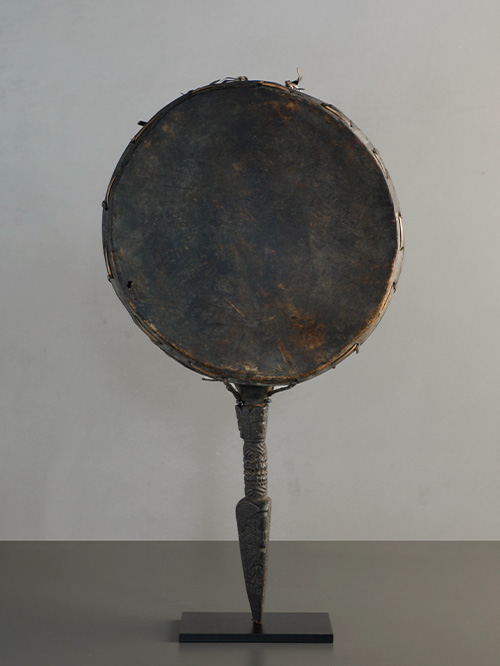
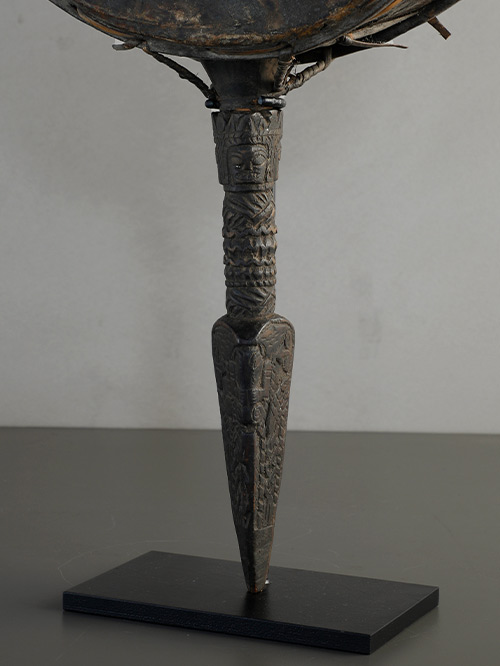
Nepal
Wood, hide and cane
The dhyangro is a double-headed frame drum used by jhakris (tribal shamans), especially those of the Magars, the Kirati, and the Tamang, in the Middle Hills region of the Himalayas in Nepal. It is considered an ancient tool of magic and has been used by shamans for centuries to enter a trance and channel benevolent helping deities. The drum is played by holding the handle in the left hand, with the frame level with the face, and striking the outer head with the right hand holding a curved stick.
The drum has hide drumheads stretched over a circular wooden rim, secured with rattan strips. The handle is elongated and carved to resemble a phurba or esoteric dagger found in Tibetan Buddhist ritual. The handle features ornate relief carving depicting three deity heads and many shamanistic symbols, such as endless knots and caduceus-like symbols, that encircle it.
Size (cms): 65(H) x 35(W) x 14(D)
Size (inches): 25.5(H) x 14(W) x 5.5(D)
-
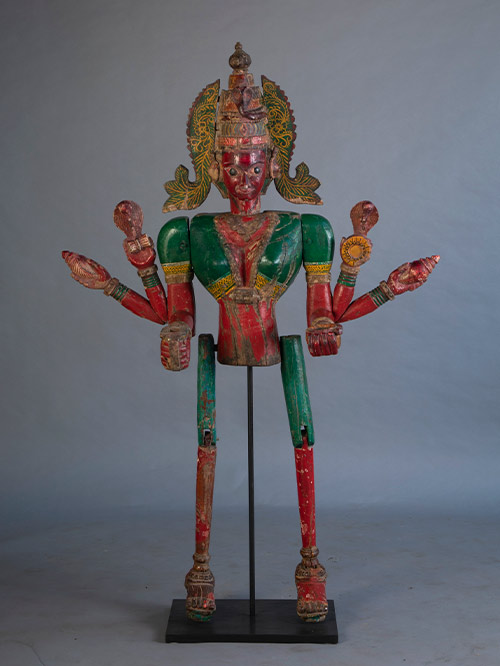
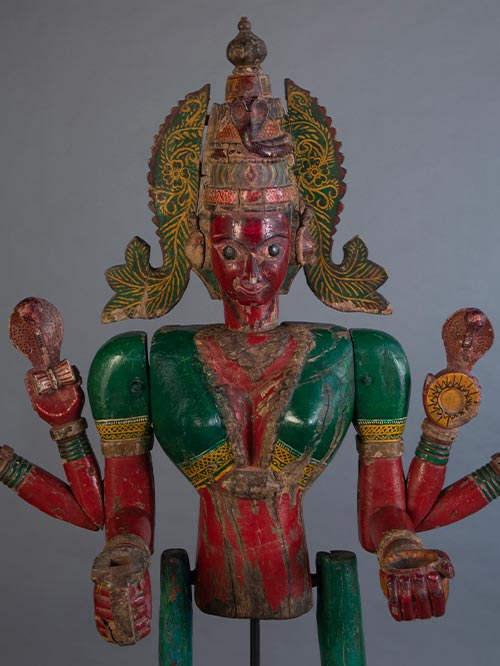
Karnataka
Wood, polychromed
An attractive multi-armed articulated standing figure of the Goddess Durga. Painted in a deep red, she wears a patterned green and yellow blouse. Her hands are adorned with multiple bangles and she carries a pair of nagas and conches in her upper hands with a blood bowl and sword in her lower two hands. An elaborate tiered crown sits on her head, decorated with geometric symbols and a serpent (naga).
Durga – “The Unconquerable form of Devi” – Durga is the most splendid manifestation of Devi. Virginal and sublime, contain within her the power of all the gods combined, she is the invincible power of Nature who triumphs over those who seek to subjugate her.
Size (cms): 132(H) x 88(W) x 31(D)
Size (inches): 52(H) x 34.5(W) x 12(D)
-
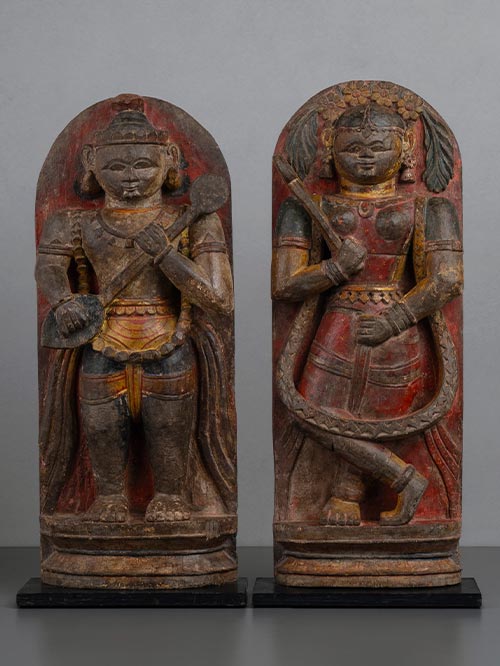
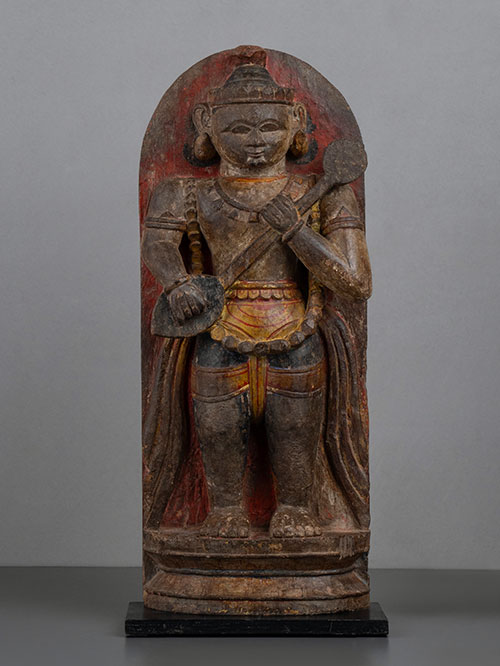
Orissa
Wood, polychromed
This beautiful pair of richly polychromed brackets depicts a musician carrying a string instrument and an attendant figure holding a chauri (fly-whisk). Standing on stepped bases, both figures are adorned with rich garments and wear long floral garlands. These figures likely originated from a natamandir, an addition to the shrine often adorned with sculptures of Devadasis and musicians.
Size (cms): 50(H) x 21(W) x 10(D)
Size (inches): 19.5(H) x 8.5(W) x 4(D)
-
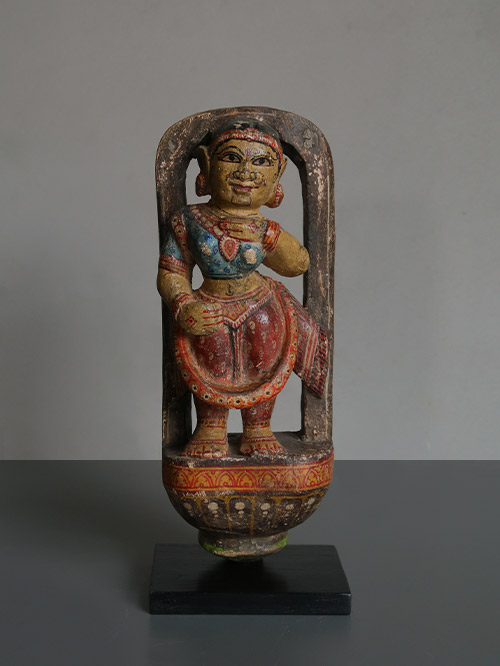
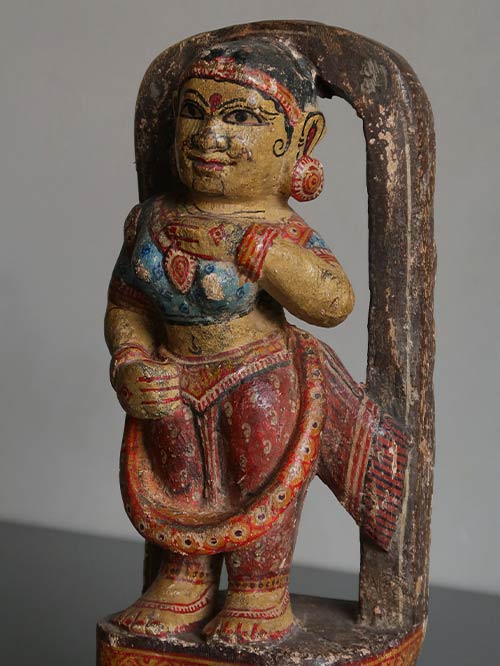
Orissa
Wood, polychromed
An elegant figure of an apsara wearing a patterned blouse. The apsara wears extensive jewellery; including multiple hand and leg ornaments. She has a stylised form with a narrow waist and large breasts and carries a flute in her hands. She has a full face with a pronounced chin, large arched eyebrows over bulbous eyes and a gentle smile.
Apsaras means ‘essence of the waters’ or ‘moving in or between the waters’. The Apsaras are divine beauties, the dancers of the gods, who dwell in Indra’s paradise, svarga (heaven). Mistresses of the Gandharva’s (semi divine beings) and, occasionally, of men, they can assume any form at will. Generally they are believed to have originated from the churning of the ocean, alone with the wish fulfilling Parijata, their favoured tree. They are often sent by the gods to seduce Rishis (holy men) and ascetics. Heroes who fall in battle are swept away to Svarga by the Apsaras. They are reputed to dwell in trees along with the Gandharvas. The chief of the Apsaras is Urvashi.
Size (cms): 33(H) x 13(W) x 10(D)
Size (inches): 13(H) x 5(W) x 4(D)
-
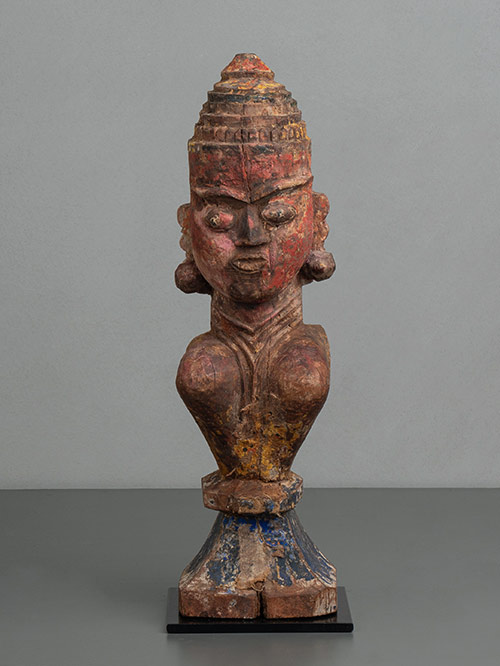
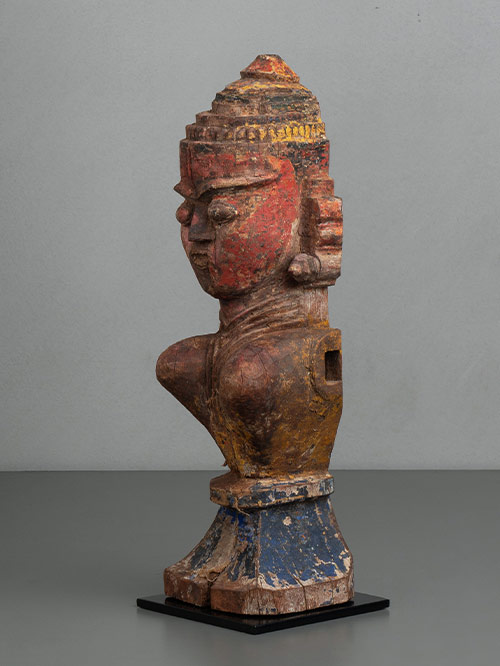
Karnataka
Wood with traces of polychroming
This decorative folk bust of Durga has an austere expression and an exaggeratedly proportioned torso, once painted to resemble a blouse. She is richly adorned with globular earrings, layered necklaces that hang low on her chest, and a striking tiered crown.
Durga – “The Unconquerable form of Devi” – Durga is the most splendid manifestation of Devi. Virginal and sublime, contain within her the power of all the gods combined, she is the invincible power of Nature who triumphs over those who seek to subjugate her. Durga is one of the names of the goddess that is the wife of Shiva. Durga has the role of a warrior goddess who destroys demons. She is usually depicted with ten arms that hold the weapons of the various gods. Her vahana is a lion which acts as her means of transportation and one of her many weapons.
During festive occasions, the utsavar (portable figures of deities) are placed on chariots or pedestals in the mandapam (audience hall of a temple) or on their respective vahana (vehicle) and taken out for public viewing or darshana. Darshana refers to the occasion where the devotee is not only able to see the image of the deity but also to sense its omnipresence.
Size (cms): 39(H) x 13(W) x 13(D)
Size (inches): 15.5(H) x 5(W) x 5(D)
-
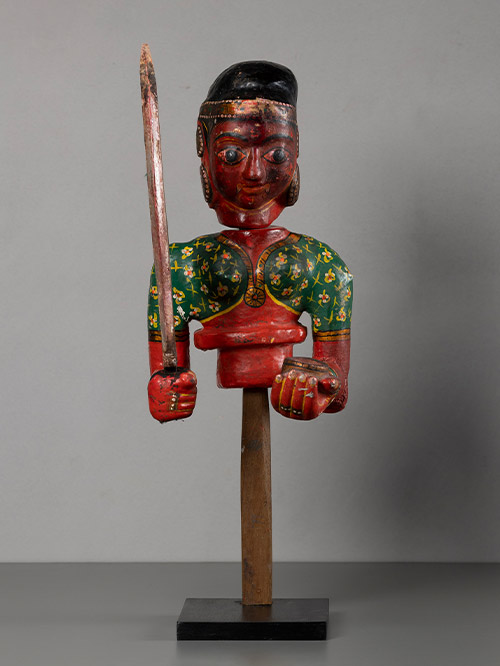
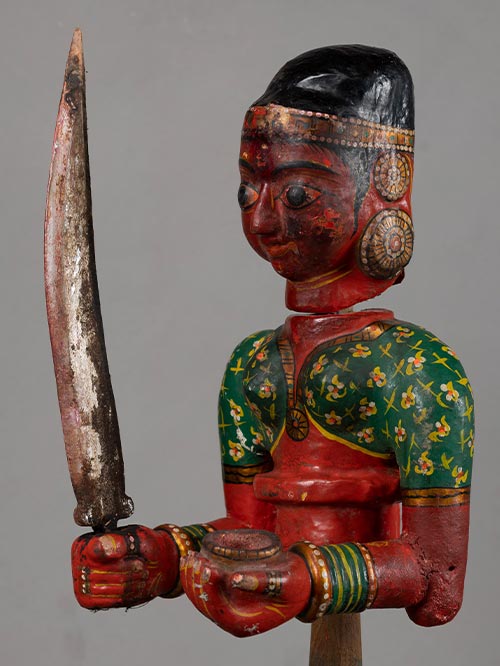
Karnataka
Wood, extensively polychromed
A fine two armed bust of the Goddess Durga wearing a patterned blue blouse. She is adorned with jewelled necklaces and bracelets and wears large globular earrings. In her hands she carries a sword and a bowl.
Durga – “The Unconquerable form of Devi” – Durga is the most splendid manifestation of Devi. Virginal and sublime, contain within her the power of all the gods combined, she is the invincible power of Nature who triumphs over those who seek to subjugate her. Durga is one of the names of the goddess that is the wife of Shiva. Durga has the role of a warrior goddess who destroys demons. She is usually depicted with ten arms that hold the weapons of the various gods. Her vahana is a lion which acts as her means of transportation and one of her many weapons.
During festive occasions, the utsavar (portable figures of deities) are placed on chariots or pedestals in the mandapam (audience hall of a temple) or on their respective vahana (vehicle) and taken out for public viewing or darshana. Darshana refers to the occasion where the devotee is not only able to see the image of the deity but also to sense its omnipresence.
Size (cms): 59(H) x 20(W) x 18(D)
Size (inches): 23(H) x 8(W) x 7(D)
-
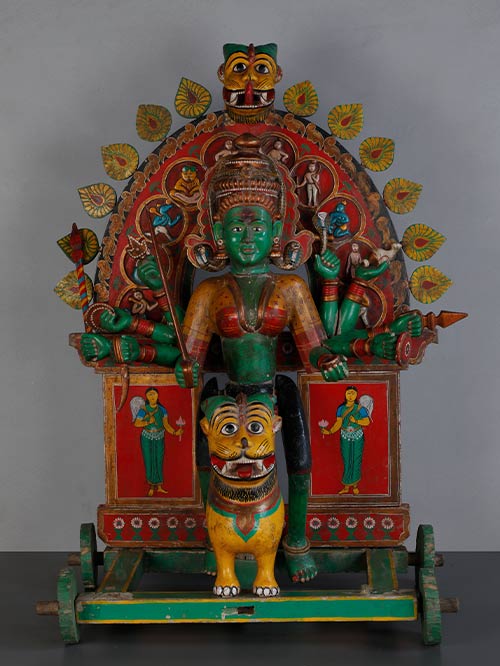
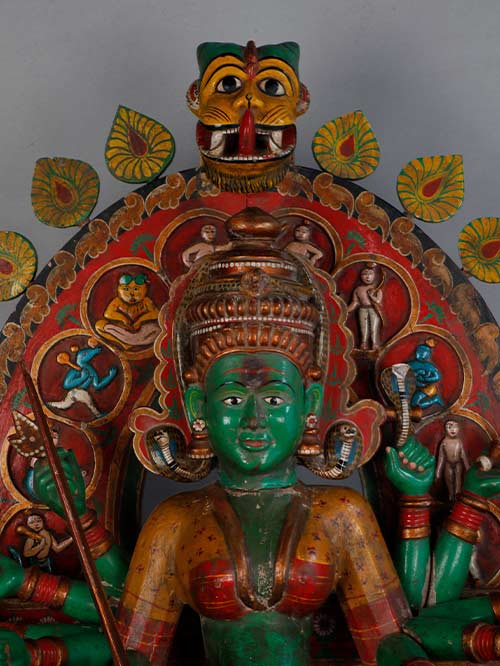
Karnataka
Wood, extensively polychromed
An exceptional multi-armed articulated figure of the Goddess Durga riding her Tiger vahana. She is seated on a complete chariot with a resplendent prabhavali which is painted with chauri bearers and a flaming aureole. Diminutive roundels are placed in an arch within the prabhavali each depicting the ten incarnations of Lord Vishnu starting with Matysa and ending with Kalki. The Goddess wears a patterned red and yellow blouse and an elaborate tiered crown. In her arms she carries various weapons, including a sword, cakra, conch, naga and blood bowl.
Durga – “The Unconquerable form of Devi” – Durga is the most splendid manifestation of Devi. Virginal and sublime, contain within her the power of all the gods combined, she is the invincible power of Nature who triumphs over those who seek to subjugate her. Every year, during Navratri, processional images of the goddess are carried in evocative ceremonies. Depending on the day of the festival, her vahana, the vehicle on which she rides changes, with each of her vehicles holding a different and unique significance. The tiger she rides here signifies her ferociousness and strength.
Size (cms): 95(H) x 69(W) x 44(D)
Size (inches): 37.5(H) x 27(W) x 17.5(D)
-
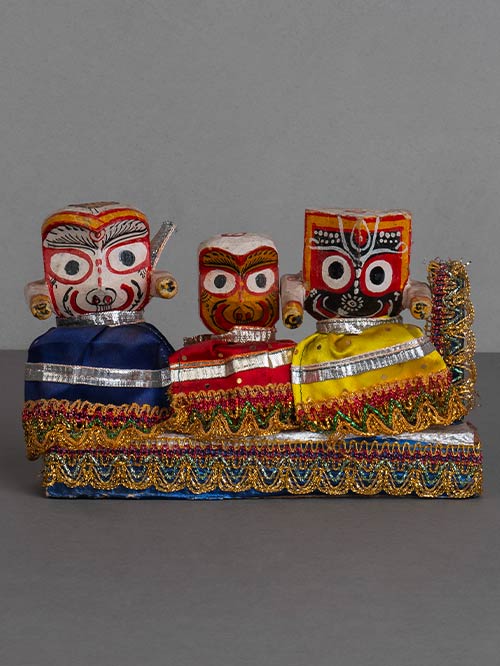
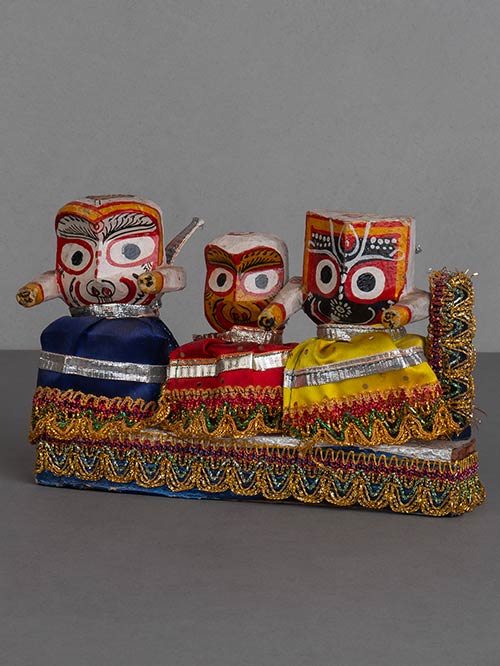
Puri (Orissa)
Wood, polychromed
In the heart of Puri lies the ancient pilgrimage centre and temple of the Jagannatha cult. There, Jagannatha, a form of Krishna, the eighth incarnation of Vishnu, is worshipped along with his brother Balabhadra and sister Subhadra. These diminutive portable figures were produced in the markets surrounding the Jagannatha temple and bought by pilgrims on their journey home. The figures are depicted as legless posts surmounted by large heads. Jagannatha (black faced) and Balabhadra (white faced) and the petite Subhadra (yellow faced).
The cult of Jagannatha in Puri is one of India’s oldest popular iconic traditions. Puri lies in Orissa is on the eastern coast of India in the Bay of Bengal. The figures of the gods remain in the temple for most of the year, but in the rainy season (June or July), they are installed in huge chariots and pulled through the streets of Puri to another temple, allowing the public to have Darshan (‘a holy view’) of the deities as they pass. It is from the huge chariots carrying Jaganath and his siblings that the English word ‘Juggernaut’ originates. Smaller figures such as these may have been used in home altars or shrines.
Size (cms): 14(H) x 21(W) x 5(D)
Size (inches): 5.5(H) x 8.5(W) x 2(D)
-
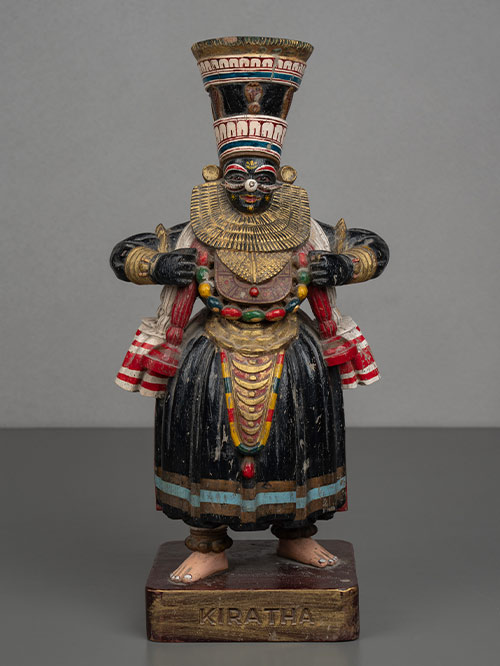

RESERVED
Kerala
Wood, extensively polychromed
An exceptional carved figure of a Kathakali dancer representing Kiratha (Shiva), with finely detailed headgear and costume.
Kiratham Kathakali is a powerful Kathakali performance based on Kirātārjunīyam, depicting Arjuna’s encounter with Lord Shiva, who appears as a hunter (Kiratha) to test his devotion. A dispute over a slain boar leads to a fierce battle, where Arjuna is ultimately defeated and realizes Shiva’s true identity. Pleased with his perseverance, Shiva grants him the divine Pashupatastra (weapon). Known for its earthy Malayalam verses, Kiratham appeals to both connoisseurs and laymen alike. It is deeply devotional, frequently performed in Shiva temples, and is typically the final story in an all-night Kathakali performance, making it a climactic and spiritually significant act.
Kathakali, a dance drama unique to Kerala, emerged in the 17th century, evolving from ritual theatre traditions and Kutiyattam Sanskrit drama. Rooted in Malayalam adaptations of the Ramayana and Mahabharata, it was traditionally performed in temple courtyards or patrons’ homes from nightfall to sunrise, often during harvest festivals or as summer entertainment. Accompanied by temple music with a unique singing style, bronze gongs, cymbals, and drums enhance the performance’s intensity. Kathakali is distinguished by elaborate costumes, ornate headgear identifying heroes and demons, stylised movements, and striking makeup in green, red, yellow, black, and white.
Size (cms): 28(H) x 14(W) x 10(D)
Size (inches): 11(H) x 5.5(W) x 4(D)
-
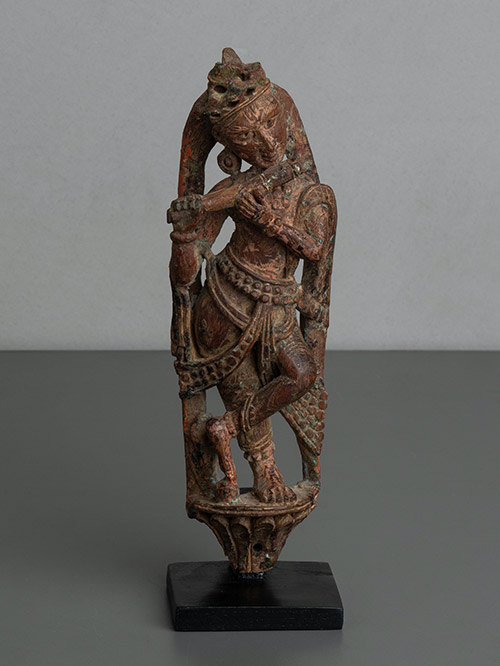
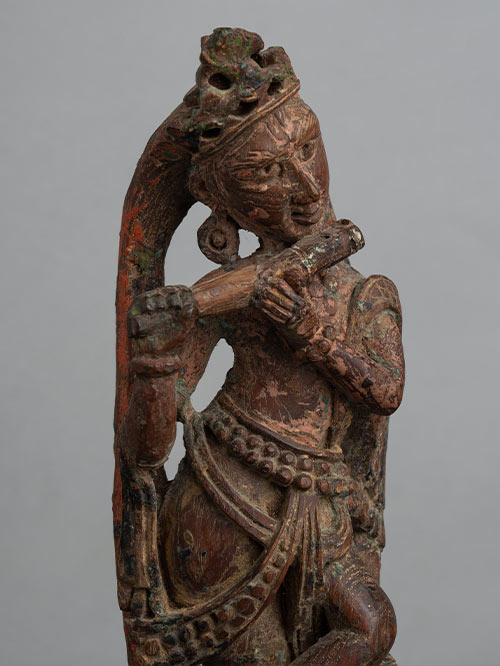
Gujarat
Wood with traces of polychroming
One of the most abiding images in Indian art is that of Krishna the flautist standing with his legs crossed at the ankles and playing the flute. He wears a decorative mukuta or crown, a dhoti and various necklaces, bangles and anklets.
The image of Venugopala rather late in Indian literature and art and it has been suggested that the classical myth of Orpheus may have exerted some influence. The idea derives from the lonely shepherd who plays his bamboo flute (venu) while tending his flock. While other cowherders f Braj hold a shepherd’s staff, Krishna’s staff is also his flute. He, however does not play upon it to please the cows, but to charm the gopis or cowherdesses
Size (cms): 24(H) x 7.5(W) x 6.5(D)
Size (inches): 9.5(H) x 3(W) x 2.5(D)
-

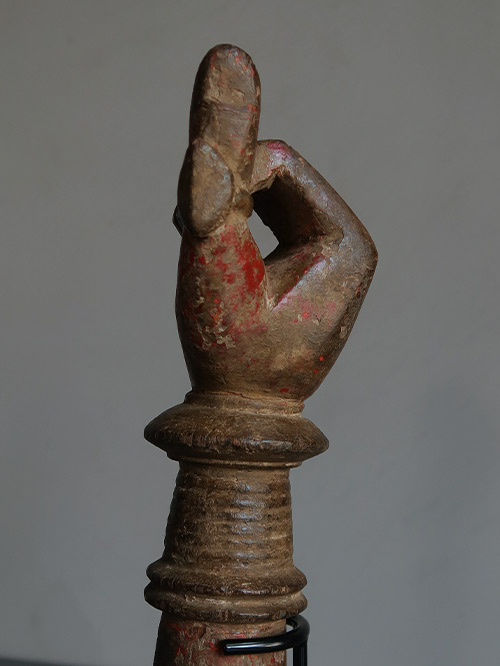
Karnataka
Wood, polychromed
A finely carved wooden hand, with original polychroming wearing bangles and rings. Originally from an articulated multi-armed processional figure of a Devi. During festive occasions, the utsavar (portable figures of deities) are placed on chariots or pedestals in the mandapam (audience hall of a temple) or on their respective vahana (vehicle) and taken out for public viewing or darshana. Darshana refers to the occasion where the devotee is not only able to see the image of the deity but also to sense its omnipresence. To enhance the visibility of the utsavar, they are elaborately dressed in dhoti or sari, garlanded with flowers and decked with the most exquisite jewellery, made of gold and semi-precious stones before being brought out in procession. Sometimes additional hands or legs are added to increase the physical presence of the image. These features may allow the deity to stand, sit or clasp multiple weapons.
Size with the Stand (cms): 34(H) x 13(W) x 7.5(D)
Size with the Stand (inches): 13.5(H) x 5(W) x 3(D)
-
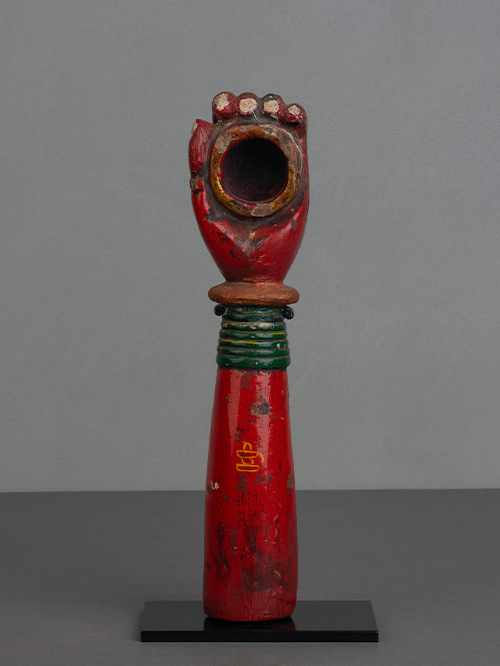
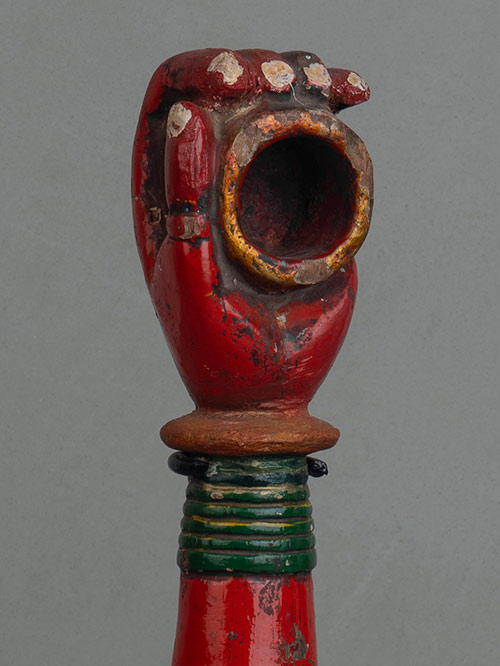
Karnataka
Wood, polychromed
A finely carved wooden hand, with original polychroming wearing bangles. She holds a blood bowl within her clenched fist and a diminutive lingam marks her forearm. Originally from an articulated multi-armed processional figure of a Devi. During festive occasions, the utsavar (portable figures of deities) are placed on chariots or pedestals in the mandapam (audience hall of a temple) or on their respective vahana (vehicle) and taken out for public viewing or darshana. Darshana refers to the occasion where the devotee is not only able to see the image of the deity but also to sense its omnipresence. To enhance the visibility of the utsavar, they are elaborately dressed in dhoti or sari, garlanded with flowers and decked with the most exquisite jewellery, made of gold and semi-precious stones before being brought out in procession. Sometimes additional hands or legs are added to increase the physical presence of the image. These features may allow the deity to stand, sit or clasp multiple weapons.
Size with the Stand (cms):29(H) x 13(W) x 7.5(D)
Size with the Stand (inches): 11.5(H) x 5(W) x 3(D)

































